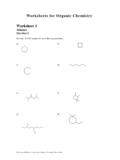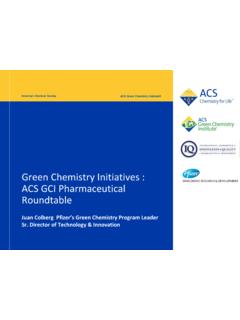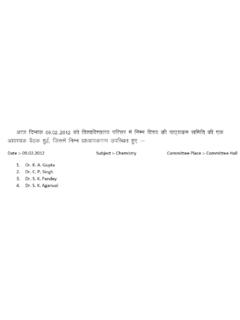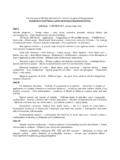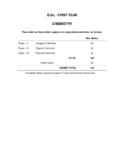Transcription of Chapter 6 Chemistry in Biology - Hall High School
1 Click on a lesson name to 6 Chemistry in BiologySection1:Atoms,Elements,andCompou ndsSection2: Chemical ReactionsSection 3: Water and SolutionsSection 4: The Building Blocks of LifeAtoms Chemistry is the study of Atoms, Elements, and Compounds Atomsare the building blocks of 6 Chemistry in Biology Neutrons and protons are located at the center of the atom. Protonsare positively charged particles. Neutronsare particles that have no charge. Electronsare negatively charged particles that are located outside the nucleus. Chemistry in Atoms, Elements, and CompoundsChapter 6 ElementsChemistry in Biology An elementis a pure substance that cannot be broken down into other substances by physical or chemical means. There are over 100 known elements, 92 of which occur naturally. Each element has a unique name and Atoms, Elements, and CompoundsChapter 6 The Periodic Table of ElementsChemistry in Biology Horizontal rows are called periods.
2 Vertical columns are called Atoms, Elements, and CompoundsChapter 6 IsotopesChemistry in Biology Atoms of the same element that have the same number of protons and electrons but have a different number of Atoms, Elements, and CompoundsChapter 6 Radioactive IsotopesChemistry in Biology When a nucleus breaks apart, it gives off radiation that can be detected and used for many Atoms, Elements, and CompoundsChapter 6 CompoundsChemistry in Biology A pure substance formed when two or more different elements combine Compounds are always formed from a specific combination of elements in a fixed ratio. Compounds cannot be broken down into simpler compounds or elements by physical Atoms, Elements, and CompoundsChapter 6 Chemical BondsChemistry in Biology Covalent bonds Chemical bond that forms when electrons are shared A moleculeis acompound in which the atoms are held together by covalent Atoms, Elements, and CompoundsChapter 6 Ionic BondsChemistry in Biology Electrical attraction between two oppositely charged atoms or groups of Atoms, Elements, and CompoundsChapter 6 Chemistry in BiologyChapter 6 Chemistry in Biology The elements identified as metals tend to donate electrons.
3 The elements identified as nonmetals tend to accept Atoms, Elements, and CompoundsChapter 6 Some atoms tend to donate or accept electrons more easily than other atoms. Most ionic compounds are crystalline at room temperature and have higher melting points than molecular compounds formed by covalent in Atoms, Elements, and CompoundsChapter 6 Chemistry in Biologyvan der Waals Forces When molecules come close together, the attractive forces between slightly positive and negative regions pull on the molecules and hold them together. The strength of the attraction depends on the size of the molecule, its shape, and its ability to attract Atoms, Elements, and CompoundsChapter 6 Reactants and Products A chemical reactionis the process by which atoms or groups of atoms in substances are reorganized into different Chemical Reactions Clues that a chemical reaction has taken place include the production of heat or light, and formation of a gas, liquid, or in BiologyChemical reactionPhysical reactionChapter 6 Chemical EquationsChemistry in Biology Chemical formulas describe the substances in the reaction and arrows indicate the process of change.
4 Reactantsare the starting substances, on the left side of the arrow. Productsare the substances formed during the reaction, on the right side of the Chemical ReactionsChapter 6 Glucose and oxygen react to form carbon dioxide and in Chemical ReactionsChapter 6 Chemistry in BiologyBalanced Equations The law of conservation of mass states matter cannot be created or destroyed. The number of atoms of each element on the reactant side must equal the number of atoms of the same element on the product Chemical ReactionsChapter 6 Chemistry in Biology Theactivation energyis the minimum amount of energy needed for reactants to form products in a chemical of Chemical ReactionsChapter 6 Chemistry in Biology This reaction is exothermic and released heat energy. The energy of the product is lower than the energy of the Chemical ReactionsChapter 6 Chemistry in Biology This reaction is endothermic and absorbed heat energy. The energy of the products is higher than the energy of the Chemical ReactionsChapter 6 Chemistry in Biology A catalystis a substance that lowers the activation energy needed to start a chemical reaction.
5 Enzymesare biological catalysts. It does not increase howmuch product is made and it does not get used up in the Chemical ReactionsChapter 6 Chemistry in Biology The reactants that bind to the enzyme are called substrates. The specific location where a substrate binds on an enzyme is called the active Chemical ReactionsChapter 6 Chemistry in Biology Factors such as pH, temperature, and other substances affect enzyme Chemical ReactionsChapter 6 The active site changes shape and forms the enzyme-substrate complex, which helps chemical bonds in the reactants to be broken and new bonds to in BiologyChapter 6 Water s Water and SolutionsChemistry in Biology Molecules that have an unequal distribution of charges are called polar molecules. Polarity is the property of having two opposite poles. A hydrogen bondis a weak interaction involving a hydrogen atom and a fluorine, oxygen, or nitrogen 6 Chemistry in Water and SolutionsChapter 6 Enzyme-Controlled ReactionsChemistry in BiologyChapter 6 Chemistry in BiologyHomogenous Mixtures A mixture that has a uniform composition throughout A solventis a substance in which another substance is dissolved.
6 A soluteis the substance that is dissolved in the coloring dissolved in water forms a homogenous Water and SolutionsChapter 6 Chemistry in BiologyHeterogeneous Mixtures In a heterogeneous mixture, the components remain salad is a heterogeneous Water and SolutionsChapter 6 Chemistry in Biology Substances that release hydrogen ions (H+) when dissolved in water are called acids. Substances that release hydroxide ions (OH ) when dissolved in water are called and Water and SolutionsChapter 6 Chemistry in Biology The measure of concentration of H+in a solution is called pH. Acidic solutions have pH values lower than 7. Basic solutions have pH values higher than and Water and SolutionsChapter 6 Chemistry in Biology Buffersare mixtures that can react with acids or bases to keep the pH within a particular Water and SolutionsChapter 6 Organic Chemistry The element carbon is a component of almost all biological The Building Blocks of LifeChemistry in BiologyChapter 6 Carbon has four electrons in its outermost energy level.
7 One carbon atom can form four covalent bonds with other in Biology Carbon compounds can be in the shape of straight chains, branched chains, and The Building Blocks of LifeChapter 6 MacromoleculesChemistry in Biology Carbon atoms can be joined to form carbon molecules. Macromoleculesare large molecules formed by joining smaller organic molecules together. Polymersare molecules made from repeating units of identical or nearly identical compounds linked together by a series of covalent The Building Blocks of LifeChapter 6 Chemistry in BiologyChapter 6 Chemistry in BiologyCarbohydrates Compounds composed of carbon, hydrogen, and oxygen in a ratio of one oxygen and two hydrogen atoms for each carbon atom (CH2O) The Building Blocks of LifeChapter 6 Chemistry in Biology Two monosaccharides joined together form a disaccharide. Longer carbohydrate molecules are called polysaccharides. The Building Blocks of LifeChapter 6 Values of nranging from three to seven are called simple sugars, or in BiologyLipids Molecules made mostly of carbon and hydrogen A triglyceride is a fat if it is solid at room temperature and an oil if it is liquid at room The Building Blocks of LifeChapter 6 Chemistry in Biology Lipids that have tail chains with only single bonds between the carbon atoms are called saturated fats.
8 Lipids that have at least one double bond between carbon atoms in the tail chain are called unsaturated fats. Fats with more than one double bond in the tail are called polyunsaturated The Building Blocks of LifeChapter 6 Chemistry in BiologyProteins A compound made of small carbon compounds called amino acids Amino acidsare small compounds that are made of carbon, nitrogen, oxygen, hydrogen, and sometimes The Building Blocks of LifeChapter 6 Chemistry in Biology Amino acids have a central carbon atom. One of the four carbon bonds is with hydrogen. The other three bonds are with an amino group ( NH2), a carboxyl group ( COOH), and a variable group ( R). The Building Blocks of LifeChapter 6 Chemistry in BiologyChapter 6 Chemistry in Biology The number and the order in which the amino acids are joined define the protein s primary structure. After an amino acid chain is formed, it folds into a unique three-dimensional shape, which is the protein s secondary structure, such as a helix or a The Building Blocks of LifeChapter 6 Chemistry in Biology Nucleic acidsare complex macromolecules that store and transmit genetic information.
9 Nucleic acids are made of smaller repeating subunits called nucleotides, composed of carbon, nitrogen, oxygen, phosphorus, and hydrogen The Building Blocks of LifeChapter 6 Chemistry in BiologyChapter Resource MenuChapter Diagnostic QuestionsFormative Test QuestionsChapter Assessment QuestionsStandardized Test BiologyTransparenciesImage BankVocabularyAnimationChapter 6 Click on a hyperlink to view the corresponding A B C D0%0%0%0% of the following particles is negatively charged? Chemistry in BiologyChapter Diagnostic QuestionsChapter A B C D0%0%0%0% Chemistry in BiologyChapter Diagnostic QuestionsChapter are created by a change in the number of what particle of an atom? A B C D0%0%0%0% Chemistry in BiologyChapter Diagnostic QuestionsChapter the proteins that speed up the rate of chemical in BiologyChapter and and and neutronsWhat particles are in an atom s nucleus? Formative Questions A B C0%0%0% in BiologyChapter Formative Questions A B C0%0%0% equal number of protons and equal number of protons and equal number of neutrons and electronsWhat causes the overall charge of an atom to be zero?
10 In BiologyChapter Formative mixtureWhat type of substance is water? A B C D0%0%0%0% in BiologyChapter Formative der Waals forcesWhat provides the energy for all living processes? A B C D0%0%0%0% in BiologyChapter Formative match evaporatingWhich is a chemical reaction? A B C D0%0%0%0% in BiologyChapter Formative QuestionsWhich chemical reaction is endothermic? A B0%0% in BiologyChapter Formative acts as a reduces the amount of heat increases the amount of lowers the activation does an enzyme increase the rate of a chemical reaction? A B C D0%0%0%0% in BiologyChapter Formative Questions A B C D0%0%0%0%What occurs at the active site in the enzyme substrate complex? exothermic chemical reaction takes bonds are broken and new bonds are enzyme gets used up in the substrates provide energy for the in BiologyChapter Formative Questions A B C D0%0%0%0% acts as a pH is is a polar is an ionic is water able to dissolve a wide variety of solutes?

